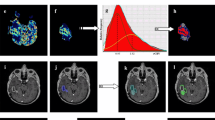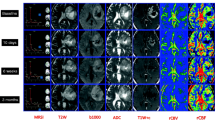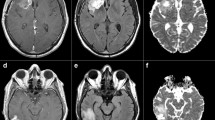Abstract
Objectives
To determine the diagnostic superiority of parametric response mapping of apparent diffusion coefficient (ADCPR) for predicting glioblastoma treatment response, compared to single time point measurement.
Methods
Fifty post-treatment glioblastoma patients were enrolled. ADCPR was calculated from serial apparent diffusion coefficient (ADC) maps acquired before and at the time of first detection of an enlarged contrast-enhancing lesion on voxel-by-voxel basis. The percentage-decrease in ADCPR and tenth percentile histogram cutoff value of ADC (ADC10) were compared at subsequent 3-month and 1-year follow-ups.
Results
The percentage-decrease in ADCPR was significantly higher in the progression group (mean = 33.2–38.3 %) than in the stable-response group (mean = 9.7 %) at 3 months follow-up (corrected p < 0.001 for both readers). ADCPR significantly improved area under the receiver operating characteristic curve from 0.67 to 0.88 (corrected p = 0.037) and from 0.70 to 0.92 (corrected p = 0.020) for both readers, respectively, compared to ADC10 at 3-month follow-up, but did not significantly improve at 1-year follow-up. The inter-reader agreement was higher for ADCPR than ADC10 (intraclass correlation coefficient, 0.93 versus 0.86).
Conclusion
Voxel-based ADCPR appears to be a superior imaging biomarker than ADC, particularly for predicting early tumour progression in patients with glioblastoma.
Key points
• Treatment response pattern of glioblastoma was evaluated using voxel-based ADCPR and ADC10.
• Voxel-based ADCPR was more accurate in predicting treatment response pattern than ADC10.
• Inter-reader agreement was higher in ADCPR calculation than in ADC10 calculation.
• Voxel-based ADCPR can be a predictor of early treatment response pattern for glioblastoma.





Similar content being viewed by others
Abbreviations
- CCRT:
-
Concurrent chemoradiotherapy
- GBM:
-
Glioblastoma
- ROC:
-
Receiver operating characteristic
- AUC:
-
Area under the ROC curve
- DWI:
-
Diffusion-weighted imaging
- ADC:
-
Apparent diffusion coefficient
- ADCPR:
-
Parametric response mapping of apparent diffusion coefficient
- ADC10 :
-
10th percentile cutoff of value of apparent diffusion coefficient
References
Kumar AJ, Leeds NE, Fuller GN et al (2000) Malignant gliomas: MR imaging spectrum of radiation therapy- and chemotherapy-induced necrosis of the brain after treatment. Radiology 217:377–384
Barajas RF Jr, Chang JS, Segal MR et al (2009) Differentiation of recurrent glioblastoma multiforme from radiation necrosis after external beam radiation therapy with dynamic susceptibility-weighted contrast-enhanced perfusion MR imaging. Radiology 253:486–496
Wen PY, Macdonald DR, Reardon DA et al (2010) Updated response assessment criteria for high-grade gliomas: response assessment in neuro-oncology working group. J Clin Oncol 28:1963–1972
Chung WJ, Kim HS, Kim N, Choi CG, Kim SJ (2013) Recurrent glioblastoma: optimum area under the curve method derived from dynamic contrast-enhanced T1-weighted perfusion MR imaging. Radiology 269:561–568
Harry VN, Semple SI, Parkin DE, Gilbert FJ (2010) Use of new imaging techniques to predict tumour response to therapy. Lancet Oncol 11:92–102
Oh J, Henry RG, Pirzkall A et al (2004) Survival analysis in patients with glioblastoma multiforme: predictive value of choline-to-N-acetylaspartate index, apparent diffusion coefficient, and relative cerebral blood volume. J Magn Reson Imaging 19:546–554
Moffat BA, Chenevert TL, Lawrence TS et al (2005) Functional diffusion map: a noninvasive MRI biomarker for early stratification of clinical brain tumor response. Proc Natl Acad Sci U S A 102:5524–5529
Galban CJ, Chenevert TL, Meyer CR et al (2009) The parametric response map is an imaging biomarker for early cancer treatment outcome. Nat Med 15:572–576
Hamstra DA, Galban CJ, Meyer CR et al (2008) Functional diffusion map as an early imaging biomarker for high-grade glioma: correlation with conventional radiologic response and overall survival. J Clin Oncol 26:3387–3394
Chiba Y, Kinoshita M, Okita Y et al (2012) Use of (11)C-methionine PET parametric response map for monitoring WT1 immunotherapy response in recurrent malignant glioma. J Neurosurg 116:835–842
Tsien C, Galban CJ, Chenevert TL et al (2010) Parametric response map as an imaging biomarker to distinguish progression from pseudoprogression in high-grade glioma. J Clin Oncol 28:2293–2299
Vogelbaum MA, Jost S, Aghi MK et al (2012) Application of novel response/progression measures for surgically delivered therapies for gliomas: Response Assessment in Neuro-Oncology (RANO) Working Group. Neurosurgery 70:234–243, discussion 243-234
Ellingson BM, Cloughesy TF, Lai A, Nghiemphu PL, Pope WB (2012) Nonlinear registration of diffusion-weighted images improves clinical sensitivity of functional diffusion maps in recurrent glioblastoma treated with bevacizumab. Magn Reson Med 67:237–245
Moffat BA, Chenevert TL, Lawrence TS et al (2005) Functional diffusion map: a noninvasive MRI biomarker for early stratification of clinical brain tumor response. Proc Natl Acad Sci U S A 102:5524–5529
Sundgren PC, Fan X, Weybright P et al (2006) Differentiation of recurrent brain tumor versus radiation injury using diffusion tensor imaging in patients with new contrast-enhancing lesions. Magn Reson Imaging 24:1131–1142
Henry RG, Vigneron DB, Fischbein NJ et al (2000) Comparison of relative cerebral blood volume and proton spectroscopy in patients with treated gliomas. AJNR Am J Neuroradiol 21:357–366
Ellingson BM, Cloughesy TF, Zaw T et al (2012) Functional diffusion maps (fDMs) evaluated before and after radiochemotherapy predict progression-free and overall survival in newly diagnosed glioblastoma. Neuro Oncol 14:333–343
Hamstra DA, Chenevert TL, Moffat BA et al (2005) Evaluation of the functional diffusion map as an early biomarker of time-to-progression and overall survival in high-grade glioma. Proc Natl Acad Sci U S A 102:16759–16764
Acknowledgments
The scientific guarantor of this publication is Prof. Sang Joon Kim. The authors state that this work has not received any funding. The Institutional Review Board approved our study (The Institutional Review Board of Asan Medical Center [http://eirb.amc.seoul.kr]: S2014-0072-0002). Written informed consent was waived by the Institutional Review Board. Methodology: retrospective, diagnostic or prognostic study, performed at one institution. The authors thank the Biomedical Imaging Infrastructure, Department of Radiology, Asan Medical Center for the technical support of image processing, and Prof. Hwa Jung Kim for the statistical support and valuable contributions.No study subjects or cohorts have been previously reported. Methodology: retrospective, diagnostic or prognostic study, performed at one institution.
Author information
Authors and Affiliations
Corresponding author
Rights and permissions
About this article
Cite this article
Yoon, R.G., Kim, H.S., Kim, D.Y. et al. Apparent diffusion coefficient parametric response mapping MRI for follow-up of glioblastoma. Eur Radiol 26, 1037–1047 (2016). https://doi.org/10.1007/s00330-015-3896-8
Received:
Revised:
Accepted:
Published:
Issue Date:
DOI: https://doi.org/10.1007/s00330-015-3896-8




